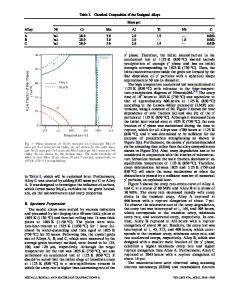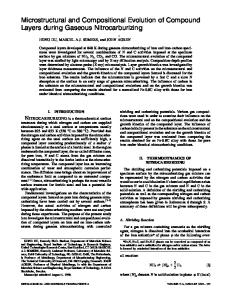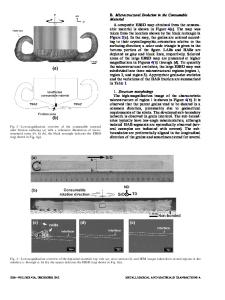Microstructural evolution during creep of single-phase gamma TiAl
- PDF / 450,630 Bytes
- 6 Pages / 612 x 792 pts (letter) Page_size
- 88 Downloads / 356 Views
I.
INTRODUCTION
TITANIUM aluminides have received considerable attention in recent years and are considered to be strong candidates for use as high-temperature materials.[1,2] However, the current state of knowledge regarding the creep behavior of these alloys has recently been summarized as ‘‘limited, lacking in the detailed understanding of the effects of specific microstructural variables.’’[3,4] The comment is motivated, in part, by the fact that the majority of studies addressing the creep behavior of g-TiAl have been based on the phenomenological description of pure metal creep. Attempts to resolve the measured values of the activation energy (Qcreep) and stress exponent (n) for creep with the activation energy for diffusion (Qdiff) and a pure metal exponent of ;4.5 have been largely unsuccessful. Published values of Qcreep range from 192 to 700 kJ/mol,[5–11] and n has generally been measured to be much closer to 8 than 4.5.[5–7,9,10,12–14] Despite the fact that creep curves of TiAl have a general shape that is similar to pure metals, the limited nature of secondary creep and increased importance of tertiary or ‘‘inverse’’ creep suggest that the traditional method for describing pure metal creep is not valid for TiAl. Moreover, detailed investigation of the intermediate temperature creep behavior of single-phase g-TiAl has led to the conclusion that a microstructural steady state is not attained,[15] and transmission electron microscopy (TEM) observations have MIN LU, formerly Graduate Student, Department of Mechanical Engineering, The Johns Hopkins University, is Engineer with Precision Castparts Corp., Portland, OR. K.J. HEMKER, Associate Professor, is with the Department of Mechanical Engineering, The Johns Hopkins University, Baltimore, MD 21218. This article is based on a presentation made in the symposium ‘‘Fundamentals of Gamma Titanium Aluminides,’’ presented at the TMS Annual Meeting, February 10–12, 1997, Orlando, Florida, under the auspices of the ASM/MSD Flow & Fracture and Phase Transformations Committees. METALLURGICAL AND MATERIALS TRANSACTIONS A
shown that the microstructure evolves throughout creep.[6,15,16] In the absence of a pure metal description of power-law creep, an alternative method for modeling the creep behavior of g-TiAl is needed. This article is aimed at measuring the development of substructure as a function of strain and correlating these measurements with creep behavior. More specifically, the deformation mechanisms associated with primary, secondary, and inverse creep are identified, and the relative density of dislocations is measured as a function of strain. The increase in creep rate is compared with the increase in dislocation density through an Orowan-type relation.
II.
EXPERIMENTAL TECHNIQUE
The material used in this study has a nominal composition of Ti-51Al-2Mn (at. pct) and was provided by P.L. Martin, Rockwell International Corporation (Thousand Oaks, CA), and R.W. Hayes, Metals Technology (Northridge, CA). A more complete description of the processing condit
Data Loading...











